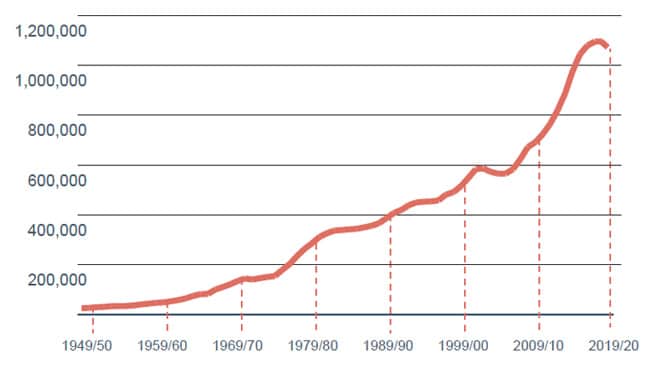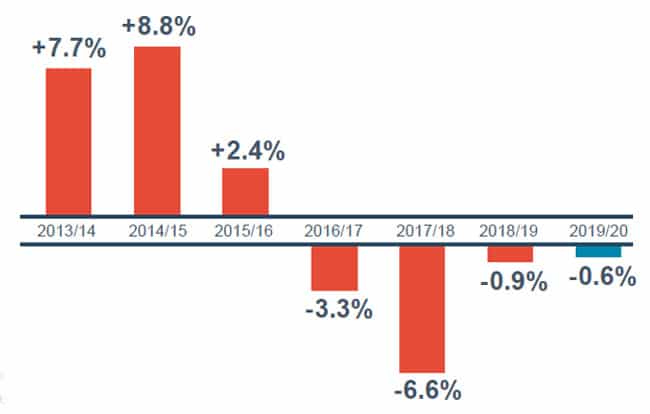Surveys show foreign enrolment declines in the US in 2019/20 and impact of COVID-19
- A fall 2020 survey of 700 US colleges shows the profound effect of COVID-19 on international enrolments: 16% fewer foreign students were enrolled in the fall of 2020 than in the fall of 2019, and this decline was driven by a 43% drop in commencements
- One in five international students enrolled in US higher education are currently studying remotely from their home countries
- Nearly 40,000 international students who planned to study in the US this fall have deferred their start date
- A separate and larger annual survey shows a nearly 2% decline in the number of international students enrolled in US higher education programmes in 2019/20 compared with 2018/19, and a 0.6% decrease in commencements
The Institute of International Education’s (IIE) annual Open Doors survey, released today, shows that in the academic year 2019/20, total international enrolments in US higher education institutions fell by 1.8% compared with 2018/19. This is the first such decline in overall enrolment since 2005/06. The survey was conducted among 2,900 US colleges in partnership with the US Department of State.

The decrease follows two years in which growth was marginal and bolstered largely by increasing participation in Optional Practical Training (OPT), a programme that allows international students to remain in the US to work for up to three years after graduation. There was essentially no growth in OPT enrolments in 2019/20, an important factor in the overall decline in international student numbers for the academic year.

Among the fields of study that enrol the most international students, Engineering programmes saw 4.4% fewer students in 2019/20, Math and Computer Science programmes enrolled 0.9% more, and Business and Management programmes recorded a 4.2% enrolment decline.
New international enrolments (i.e., commencements) fell by 0.6% in 2019/20, the fourth straight year of declines in the number of commencements. Overall, the annual volume of new students enrolling in the US has fallen by roughly 11% from a recent-year high of 300,743 in 2015/16 to 267,712 in 2019/20.

Even so, US colleges enrolled 1,075,495 foreign students in 2019/20, and the US continues to be the world’s leading study destination.
Of the results, Marie Royce, Assistant Secretary of State for Educational and Cultural Affairs, chose to focus on the positives in her statement: “We are encouraged to see a fifth year of more than one million international students in the United States before the pandemic.”
She continued,
“International student mobility is as important today as ever, and we believe the United States is the best destination for students to study and earn their degrees. Education is a pathway to a greater future and international educational exchange has the power to transform students’ trajectories.”
Fewer students in OPT
Last year’s OPT growth of 9.6% helped overall enrolments to grow despite a 2% decrease in the number of international students enrolled in academic programmes. But in 2019/20, OPT enrolments grew by only 0.2%, as more students cycled out of the system and fewer new registrants entered.
With smaller numbers of international students in academic programmes, there is a smaller pool of students eligible for OPT, and this trend looks likely to continue for some time. The Trump administration has become increasingly wary of programmes enabling international students to remain in the US to work, including OPT and the H-1B visa programme, concerned that they may endanger American workers’ jobs.
Looking even further down the enrolment funnel for US colleges, data from a separate IIE report released last week shows that there has been a 15% decrease in the number of students on F-1 visas in American high schools since 2016. Fewer international students in American high schools reduces an important source of international students for the country’s higher education sector.
A stagnant Chinese market and a decline from India
China (35%) and India (18%) continue to compose more than half of all international enrolments in the US. In 2019/20, the number of Chinese students was virtually flat (up 0.8%) compared with 2018/19 and the number of Indian students declined by 4.4%.
The next largest source countries for US educators account for a much smaller portion of overall enrolments but they were also down from 2018/19. South Korea numbers fell by nearly 5%, Saudi Arabia fell by 3%, Canada was flat at -0.5%, and Vietnam fell by 2.5%.
Other highlights from the annual Open Doors survey include:
- Community colleges reported significant enrolment declines, down more than 8% in 2019/20.
- The largest percentage increases from source markets came from Bangladesh (+7%), Brazil (+4%), and Nigeria (+3%).
- The largest percentage decrease came from Saudi Arabia (-17%), a decline explained mostly by the end of the Saudi government’s scholarship programme.
- International students composed 5.5% of the overall student population in 2019/20 and Mirka Martel, IIE’s head of research, evaluation and learning, says, “There is substantial capacity for campuses to host more.”
- The US sent more students abroad in 2019/20; 47,099 Americans studied abroad for academic credit, a 1.6% increase over the previous year.
43% decline in commencements in fall 2020
In addition to the annual survey, IIE also released the results of a Fall 2020 Snapshot survey conducted among 700 institutions. These findings, unlike those from the annual survey, show the effect of COVID-19 in the current academic year.
The survey indicates the total number of international students in programmes delivered either in the US or online is down by 16% this fall compared to the same semester in 2019. Even more startling, commencements have fallen by 43% year-over-year. Currently, 1 in 5 students enrolled in US higher education are studying online, outside of the US.
Contributing to these steep decreases is the number of international students who have deferred their start dates: 9 in 10 surveyed institutions reported deferrals amounting to roughly 40,000 students, and the hope is that these students will enrol once the COVID-19 crisis is over.
IIE and State Department spokespeople noted that it is encouraging that 82% of responding institutions said that they are increasing online recruitment of international students despite COVID-19 and 64% have committed funding for outreach at the same level as or higher as in previous years. Such findings reveal that international educators are continuing to invest in their international programmes despite the pressures of the pandemic and a host of other factors that have made it more challenging to recruit overseas in the past few years.
Indeed, at the press briefing announcing the findings of the two surveys, IIE and State Department officials emphasised the degree to which US educators are trying to support international students in this very difficult year. According to the Fall 2020 Snapshot,
- 74% of institutions had facilitated virtual events for their international students studying online to help them feel engaged and connected to their institutions;
- 68% had adapted course schedules and online teaching methods to assist international students studying remotely in their home countries across time zones;
- 43% had leant computers to international students studying in the US;
- 29% had provided emergency funding to international students.
Different perspectives on the results
At the press briefing, Allan Goodman, IIE’s president and CEO, expressed his confidence that demand for US education would pick up after the pandemic:
“What we do know is when pandemics end, there’s tremendous pent-up demand. All of our records show in the past that when it’s safe to resume travel, we’re dealing with surges of students that have deferred, that set their plans aside, that were granted deferments and want to come. I think there’s no reason to suspect that at the end of this pandemic we won’t see the same thing.”
Anthony Kohila, the State Department’s director of the Office of Global Educational Programs, attested to the US government’s support for the country’s international education sector:
“Over the past year, the Trump administration has invested more in educational advising for the State Department’s Education USA network than any administration in history. These investments will help maintain and grow the United States as a top host nation for international students.”
Asked by a reporter about the Trump administration’s position on international students and whether this position could be viewed as “encouraging," Mr Kohila quoted Mr Trump as saying,
“Our universities are available. The world comes in. They use our universities. We have the greatest system in the world.”
NAFSA’s Executive Director and CEO Esther Brimmer, expressed a different sentiment in response to the steep enrolment declines revealed by the IIE surveys:
“Unfortunately, this disappointing news is not surprising. For the past four years international students and scholars have had to endure travel bans, executive orders, detrimental regulatory actions and xenophobic rhetoric from the highest levels of US. government. The lack of a coordinated national pandemic response made the situation even more difficult.”
Dr Brimmer’s colleague, Rachel Banks, NAFSA’s senior director for public policy and legislative strategy, went so far as to say the Trump administration has been “actively unhelpful” towards international students. “This current administration has an anti-immigrant agenda, and that gets woven into all the policies that they promulgate,” said Ms Banks.
NAFSA estimates that the economic impact of international students in the US was US$38.7 billion in 2019/20, down 4.4% compared with 2018/19. In addition, the organisation has found that the 415,995 jobs created or supported by international students in 2019/20 represents a -9.2% decrease from the previous year.
COVID impacts not limited to the US
The US is not the only major study abroad destination to be rocked by the effects of COVID-19 and associated travel restrictions, as IIE president Allan E. Goodman reminded reporters attending the virtual press briefing announcing the annual survey and Fall 2020 snapshot findings.
Australian educators are also facing serious enrolment declines as a result of their country’s continued border closures. A new report released last week anticipates a 50% drop in the number of foreign students enrolled in Australian institutions in 2021 and Australia could lose more than AUS$20 billion as international students’ spending declines sharply.
The ELT sectors in many destinations, including Canada and the UK, have also been severely affected by the pandemic.
For additional background please see:


















